Abstract
Urinary tract infections, caused mainly by Escherichia coli, are among the most common infectious diseases. Most isolates of the uropathogenic E.coli can express type 1 and P fimbriae containing adhesins that recognize cell receptors. While P fimbriae recognize kidney glycolipid receptors and are involved in peyelonephritis, the urothelial for type 1 fimbriae were not identified. We show that type 1-fimbriated E. coli recognize uroplakins Ia and Ib, two major glycoproteins of urothelial apical plaques. Anchorage of E. coli to urothelial surface via type 1 fimbriae-uroplakin I interactions may play a role in its bladder colonization and eventual ascent through the ureters, against urine flow, to invade the kidneys.
Full text
PDF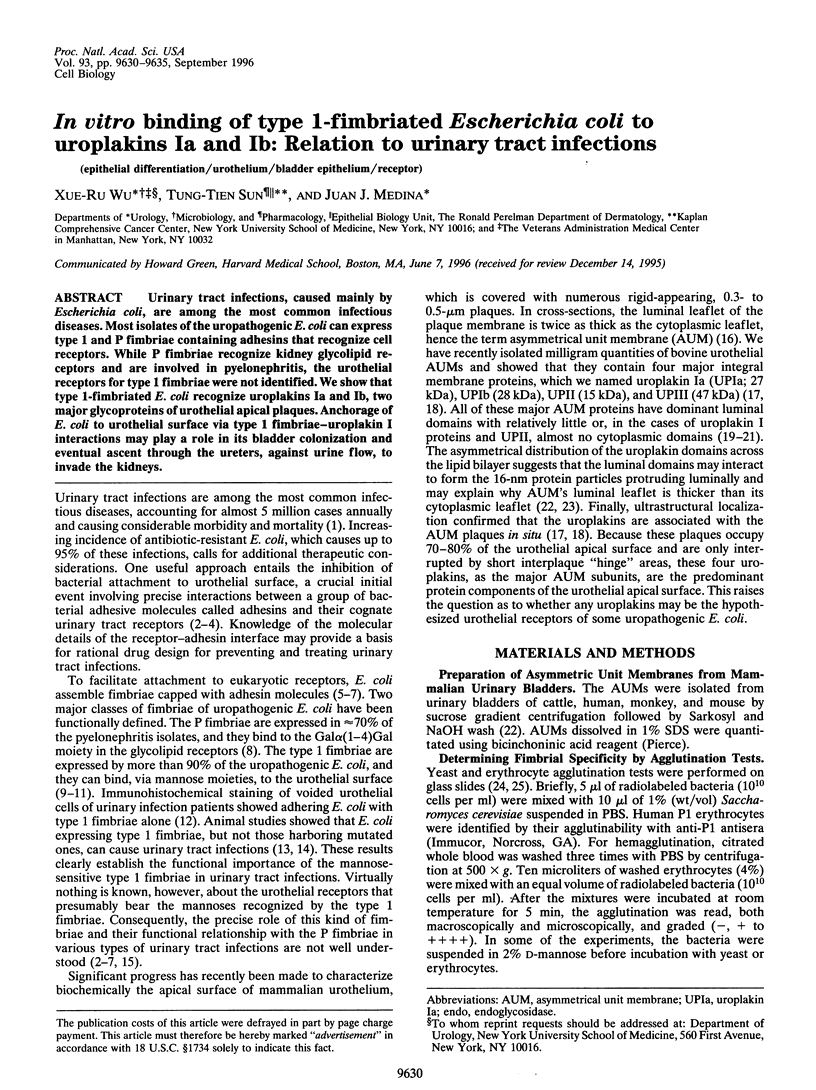
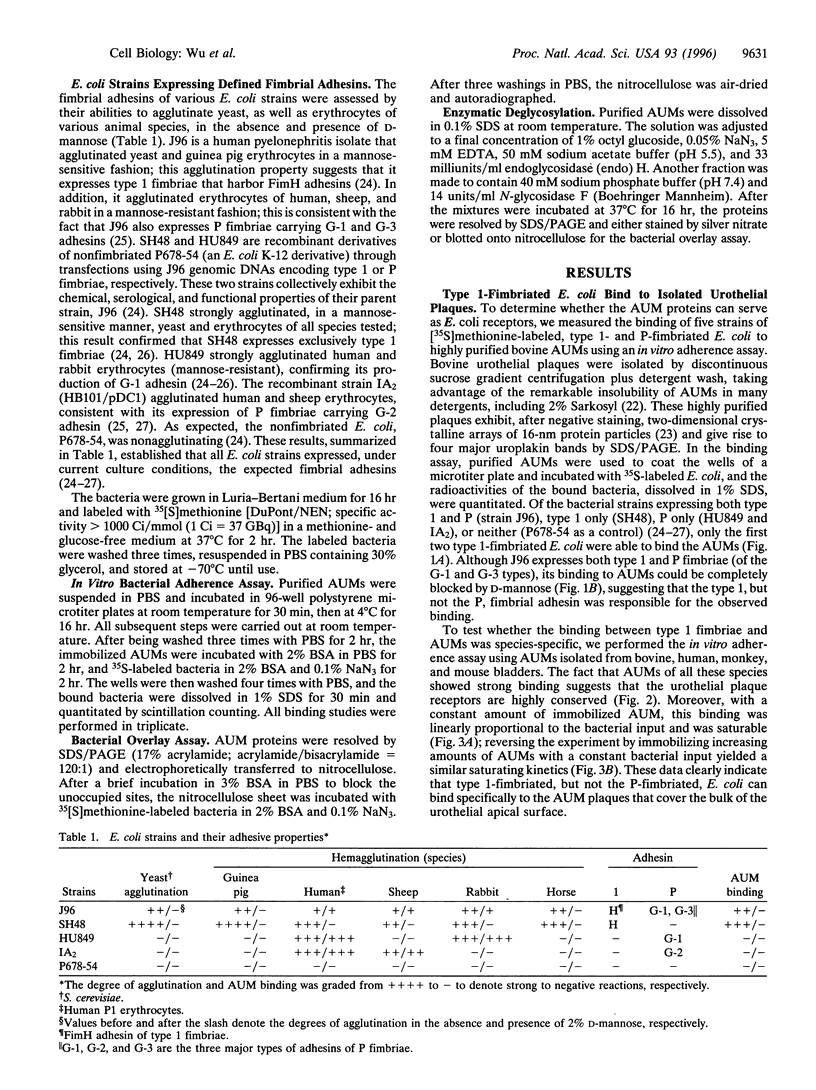
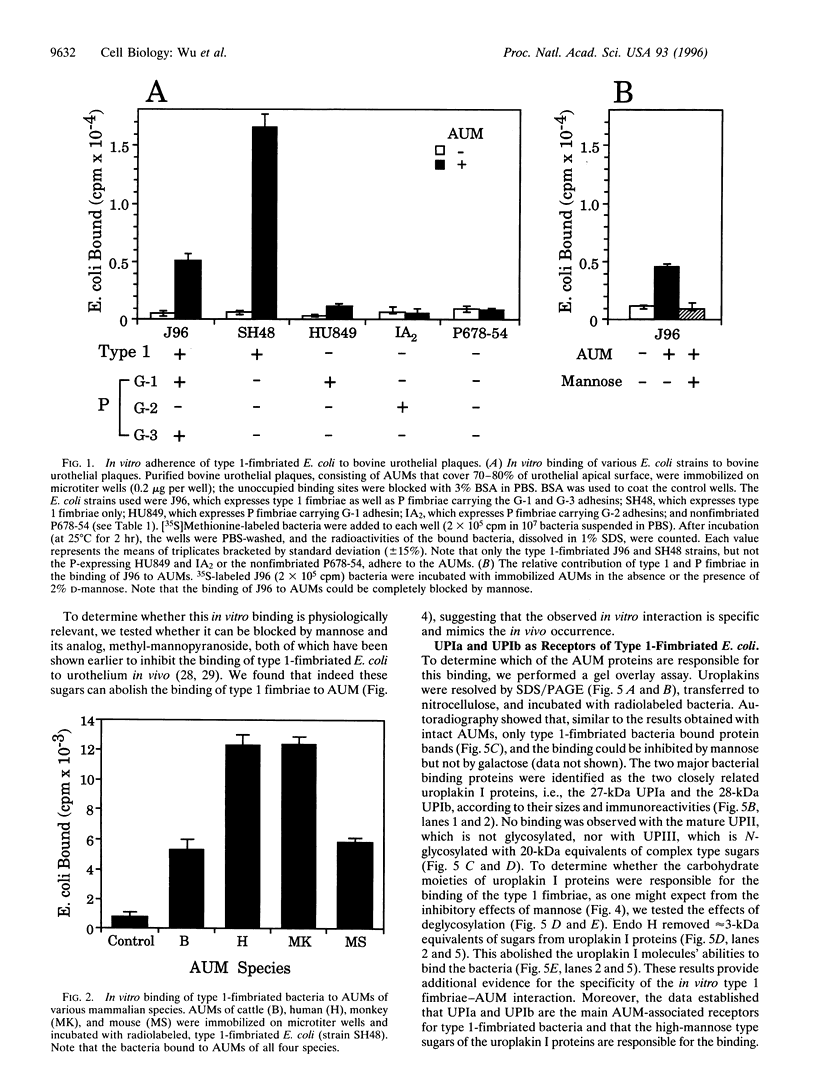
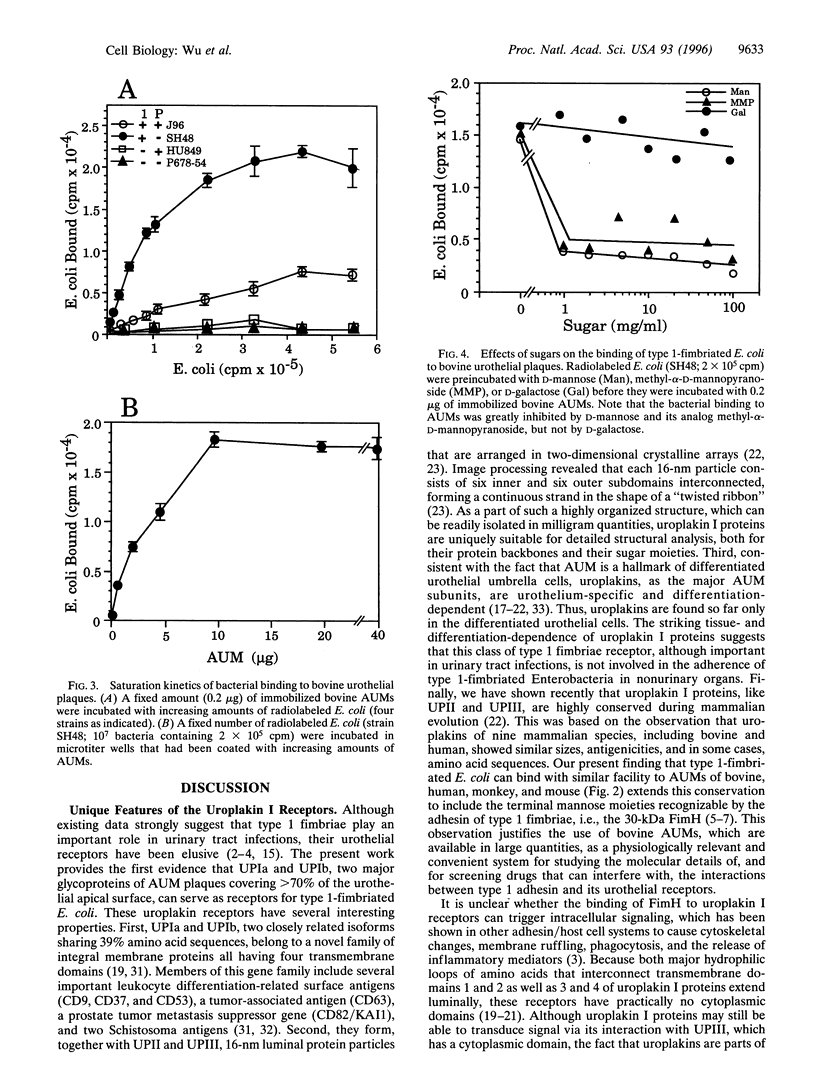
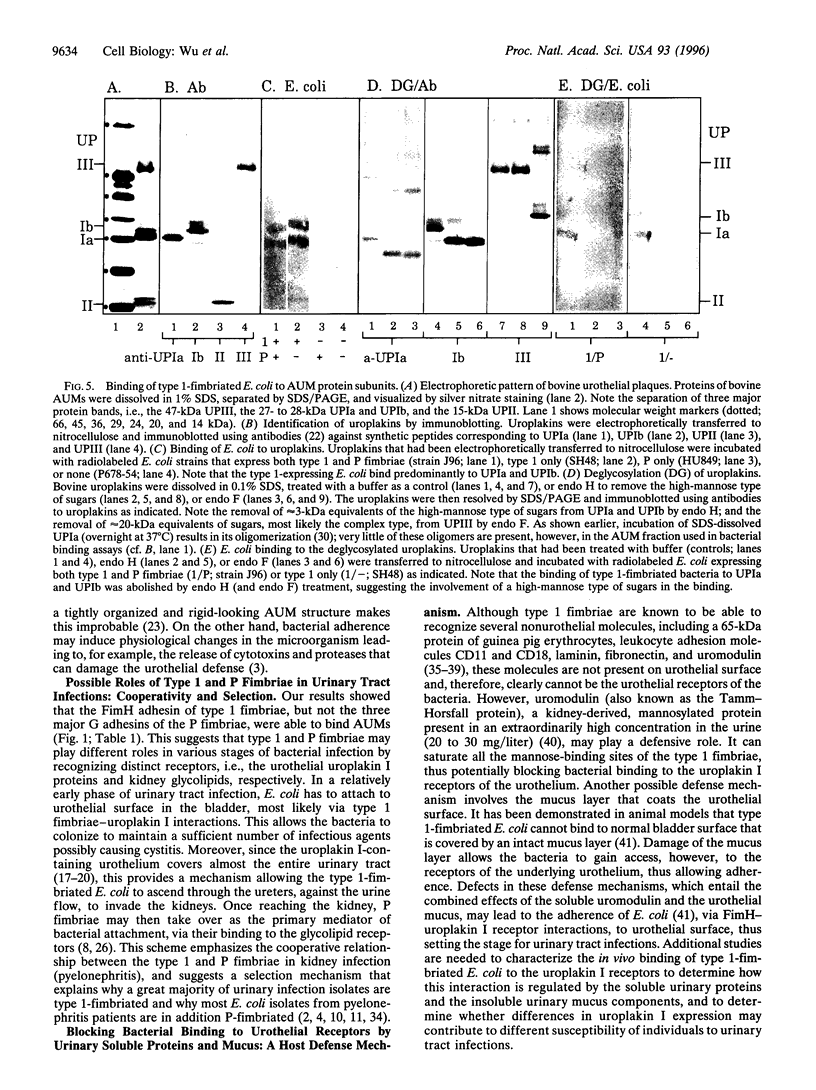
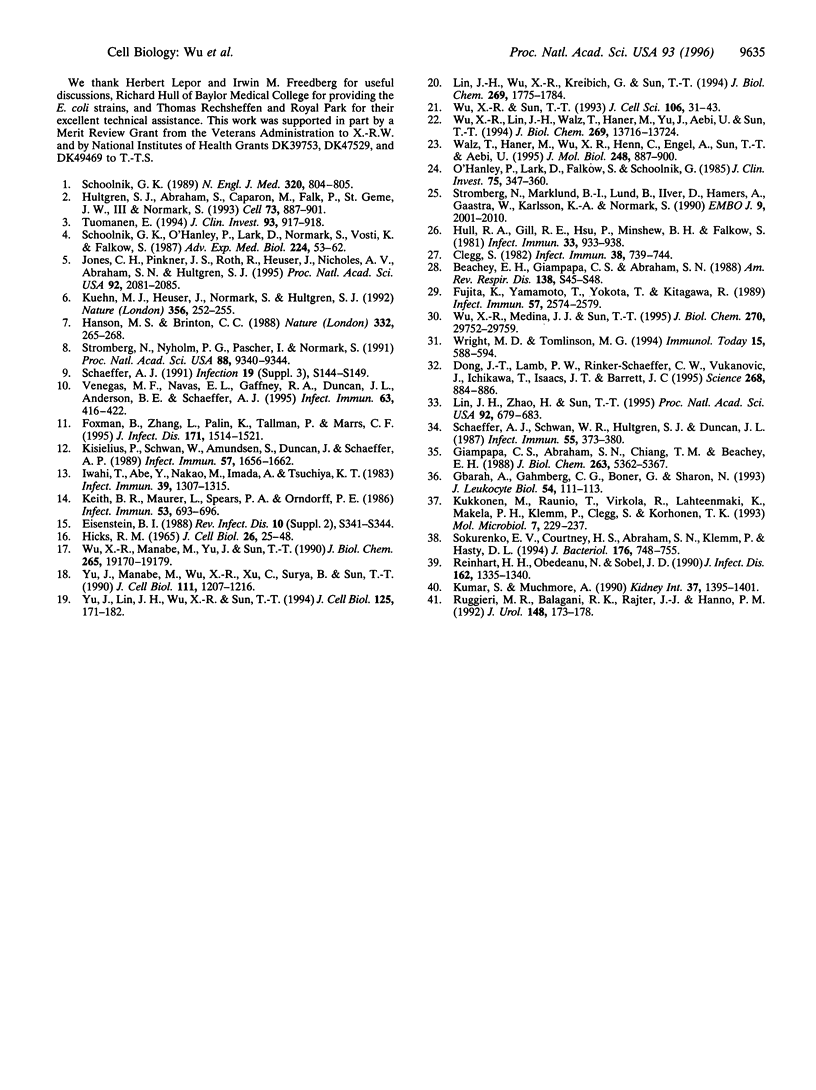
Images in this article
Selected References
These references are in PubMed. This may not be the complete list of references from this article.
- Beachey E. H., Giampapa C. S., Abraham S. N. Bacterial adherence. Adhesin receptor-mediated attachment of pathogenic bacteria to mucosal surfaces. Am Rev Respir Dis. 1988 Dec;138(6 Pt 2):S45–S48. doi: 10.1164/ajrccm/138.6_Pt_2.S45. [DOI] [PubMed] [Google Scholar]
- Clegg S. Cloning of genes determining the production of mannose-resistant fimbriae in a uropathogenic strain of Escherichia coli belonging to serogroup O6. Infect Immun. 1982 Nov;38(2):739–744. doi: 10.1128/iai.38.2.739-744.1982. [DOI] [PMC free article] [PubMed] [Google Scholar]
- Dong J. T., Lamb P. W., Rinker-Schaeffer C. W., Vukanovic J., Ichikawa T., Isaacs J. T., Barrett J. C. KAI1, a metastasis suppressor gene for prostate cancer on human chromosome 11p11.2. Science. 1995 May 12;268(5212):884–886. doi: 10.1126/science.7754374. [DOI] [PubMed] [Google Scholar]
- Eisenstein B. I. Type 1 fimbriae of Escherichia coli: genetic regulation, morphogenesis, and role in pathogenesis. Rev Infect Dis. 1988 Jul-Aug;10 (Suppl 2):S341–S344. doi: 10.1093/cid/10.supplement_2.s341. [DOI] [PubMed] [Google Scholar]
- Foxman B., Zhang L., Palin K., Tallman P., Marrs C. F. Bacterial virulence characteristics of Escherichia coli isolates from first-time urinary tract infection. J Infect Dis. 1995 Jun;171(6):1514–1521. doi: 10.1093/infdis/171.6.1514. [DOI] [PubMed] [Google Scholar]
- Fujita K., Yamamoto T., Yokota T., Kitagawa R. In vitro adherence of type 1-fimbriated uropathogenic Escherichia coli to human ureteral mucosa. Infect Immun. 1989 Aug;57(8):2574–2579. doi: 10.1128/iai.57.8.2574-2579.1989. [DOI] [PMC free article] [PubMed] [Google Scholar]
- Gbarah A., Gahmberg C. G., Boner G., Sharon N. The leukocyte surface antigens CD11b and CD18 mediate the oxidative burst activation of human peritoneal macrophages induced by type 1 fimbriated Escherichia coli. J Leukoc Biol. 1993 Aug;54(2):111–113. doi: 10.1002/jlb.54.2.111. [DOI] [PubMed] [Google Scholar]
- Giampapa C. S., Abraham S. N., Chiang T. M., Beachey E. H. Isolation and characterization of a receptor for type 1 fimbriae of Escherichia coli from guinea pig erythrocytes. J Biol Chem. 1988 Apr 15;263(11):5362–5367. [PubMed] [Google Scholar]
- Hanson M. S., Brinton C. C., Jr Identification and characterization of E. coli type-1 pilus tip adhesion protein. Nature. 1988 Mar 17;332(6161):265–268. doi: 10.1038/332265a0. [DOI] [PubMed] [Google Scholar]
- Hicks R. M. The fine structure of the transitional epithelium of rat ureter. J Cell Biol. 1965 Jul;26(1):25–48. doi: 10.1083/jcb.26.1.25. [DOI] [PMC free article] [PubMed] [Google Scholar]
- Hull R. A., Gill R. E., Hsu P., Minshew B. H., Falkow S. Construction and expression of recombinant plasmids encoding type 1 or D-mannose-resistant pili from a urinary tract infection Escherichia coli isolate. Infect Immun. 1981 Sep;33(3):933–938. doi: 10.1128/iai.33.3.933-938.1981. [DOI] [PMC free article] [PubMed] [Google Scholar]
- Hultgren S. J., Abraham S., Caparon M., Falk P., St Geme J. W., 3rd, Normark S. Pilus and nonpilus bacterial adhesins: assembly and function in cell recognition. Cell. 1993 Jun 4;73(5):887–901. doi: 10.1016/0092-8674(93)90269-v. [DOI] [PubMed] [Google Scholar]
- Iwahi T., Abe Y., Nakao M., Imada A., Tsuchiya K. Role of type 1 fimbriae in the pathogenesis of ascending urinary tract infection induced by escherichia coli in mice. Infect Immun. 1983 Mar;39(3):1307–1315. doi: 10.1128/iai.39.3.1307-1315.1983. [DOI] [PMC free article] [PubMed] [Google Scholar]
- Jones C. H., Pinkner J. S., Roth R., Heuser J., Nicholes A. V., Abraham S. N., Hultgren S. J. FimH adhesin of type 1 pili is assembled into a fibrillar tip structure in the Enterobacteriaceae. Proc Natl Acad Sci U S A. 1995 Mar 14;92(6):2081–2085. doi: 10.1073/pnas.92.6.2081. [DOI] [PMC free article] [PubMed] [Google Scholar]
- Keith B. R., Maurer L., Spears P. A., Orndorff P. E. Receptor-binding function of type 1 pili effects bladder colonization by a clinical isolate of Escherichia coli. Infect Immun. 1986 Sep;53(3):693–696. doi: 10.1128/iai.53.3.693-696.1986. [DOI] [PMC free article] [PubMed] [Google Scholar]
- Kisielius P. V., Schwan W. R., Amundsen S. K., Duncan J. L., Schaeffer A. J. In vivo expression and variation of Escherichia coli type 1 and P pili in the urine of adults with acute urinary tract infections. Infect Immun. 1989 Jun;57(6):1656–1662. doi: 10.1128/iai.57.6.1656-1662.1989. [DOI] [PMC free article] [PubMed] [Google Scholar]
- Kuehn M. J., Heuser J., Normark S., Hultgren S. J. P pili in uropathogenic E. coli are composite fibres with distinct fibrillar adhesive tips. Nature. 1992 Mar 19;356(6366):252–255. doi: 10.1038/356252a0. [DOI] [PubMed] [Google Scholar]
- Kukkonen M., Raunio T., Virkola R., Lähteenmäki K., Mäkelä P. H., Klemm P., Clegg S., Korhonen T. K. Basement membrane carbohydrate as a target for bacterial adhesion: binding of type I fimbriae of Salmonella enterica and Escherichia coli to laminin. Mol Microbiol. 1993 Jan;7(2):229–237. doi: 10.1111/j.1365-2958.1993.tb01114.x. [DOI] [PubMed] [Google Scholar]
- Kumar S., Muchmore A. Tamm-Horsfall protein--uromodulin (1950-1990). Kidney Int. 1990 Jun;37(6):1395–1401. doi: 10.1038/ki.1990.128. [DOI] [PubMed] [Google Scholar]
- Lin J. H., Wu X. R., Kreibich G., Sun T. T. Precursor sequence, processing, and urothelium-specific expression of a major 15-kDa protein subunit of asymmetric unit membrane. J Biol Chem. 1994 Jan 21;269(3):1775–1784. [PubMed] [Google Scholar]
- Lin J. H., Zhao H., Sun T. T. A tissue-specific promoter that can drive a foreign gene to express in the suprabasal urothelial cells of transgenic mice. Proc Natl Acad Sci U S A. 1995 Jan 31;92(3):679–683. doi: 10.1073/pnas.92.3.679. [DOI] [PMC free article] [PubMed] [Google Scholar]
- O'Hanley P., Lark D., Falkow S., Schoolnik G. Molecular basis of Escherichia coli colonization of the upper urinary tract in BALB/c mice. Gal-Gal pili immunization prevents Escherichia coli pyelonephritis in the BALB/c mouse model of human pyelonephritis. J Clin Invest. 1985 Feb;75(2):347–360. doi: 10.1172/JCI111707. [DOI] [PMC free article] [PubMed] [Google Scholar]
- Reinhart H. H., Obedeanu N., Sobel J. D. Quantitation of Tamm-Horsfall protein binding to uropathogenic Escherichia coli and lectins. J Infect Dis. 1990 Dec;162(6):1335–1340. doi: 10.1093/infdis/162.6.1335. [DOI] [PubMed] [Google Scholar]
- Ruggieri M. R., Balagani R. K., Rajter J. J., Hanno P. M. Characterization of bovine bladder mucin fractions that inhibit Escherichia coli adherence to the mucin deficient rabbit bladder. J Urol. 1992 Jul;148(1):173–178. doi: 10.1016/s0022-5347(17)36547-3. [DOI] [PubMed] [Google Scholar]
- Schaeffer A. J. Potential role of phase variation of type 1 pili in urinary tract infection. and bacterial prostatitis. Infection. 1991;19 (Suppl 3):S144–S149. doi: 10.1007/BF01643685. [DOI] [PubMed] [Google Scholar]
- Schaeffer A. J., Schwan W. R., Hultgren S. J., Duncan J. L. Relationship of type 1 pilus expression in Escherichia coli to ascending urinary tract infections in mice. Infect Immun. 1987 Feb;55(2):373–380. doi: 10.1128/iai.55.2.373-380.1987. [DOI] [PMC free article] [PubMed] [Google Scholar]
- Schoolnik G. K., O'Hanley P., Lark D., Normark S., Vosti K., Falkow S. Uropathogenic Escherichia coli: molecular mechanisms of adherence. Adv Exp Med Biol. 1987;224:53–62. doi: 10.1007/978-1-4684-8932-3_5. [DOI] [PubMed] [Google Scholar]
- Schoolrik G. K. How Escherichia coli infects the urinary tract. N Engl J Med. 1989 Mar 23;320(12):804–805. doi: 10.1056/NEJM198903233201211. [DOI] [PubMed] [Google Scholar]
- Sokurenko E. V., Courtney H. S., Ohman D. E., Klemm P., Hasty D. L. FimH family of type 1 fimbrial adhesins: functional heterogeneity due to minor sequence variations among fimH genes. J Bacteriol. 1994 Feb;176(3):748–755. doi: 10.1128/jb.176.3.748-755.1994. [DOI] [PMC free article] [PubMed] [Google Scholar]
- Strömberg N., Marklund B. I., Lund B., Ilver D., Hamers A., Gaastra W., Karlsson K. A., Normark S. Host-specificity of uropathogenic Escherichia coli depends on differences in binding specificity to Gal alpha 1-4Gal-containing isoreceptors. EMBO J. 1990 Jun;9(6):2001–2010. doi: 10.1002/j.1460-2075.1990.tb08328.x. [DOI] [PMC free article] [PubMed] [Google Scholar]
- Strömberg N., Nyholm P. G., Pascher I., Normark S. Saccharide orientation at the cell surface affects glycolipid receptor function. Proc Natl Acad Sci U S A. 1991 Oct 15;88(20):9340–9344. doi: 10.1073/pnas.88.20.9340. [DOI] [PMC free article] [PubMed] [Google Scholar]
- Tuomanen E. A spoonful of sugar to control inflammation? J Clin Invest. 1994 Mar;93(3):917–918. doi: 10.1172/JCI117094. [DOI] [PMC free article] [PubMed] [Google Scholar]
- Venegas M. F., Navas E. L., Gaffney R. A., Duncan J. L., Anderson B. E., Schaeffer A. J. Binding of type 1-piliated Escherichia coli to vaginal mucus. Infect Immun. 1995 Feb;63(2):416–422. doi: 10.1128/iai.63.2.416-422.1995. [DOI] [PMC free article] [PubMed] [Google Scholar]
- Walz T., Häner M., Wu X. R., Henn C., Engel A., Sun T. T., Aebi U. Towards the molecular architecture of the asymmetric unit membrane of the mammalian urinary bladder epithelium: a closed "twisted ribbon" structure. J Mol Biol. 1995 May 19;248(5):887–900. doi: 10.1006/jmbi.1995.0269. [DOI] [PubMed] [Google Scholar]
- Wright M. D., Tomlinson M. G. The ins and outs of the transmembrane 4 superfamily. Immunol Today. 1994 Dec;15(12):588–594. doi: 10.1016/0167-5699(94)90222-4. [DOI] [PubMed] [Google Scholar]
- Wu X. R., Lin J. H., Walz T., Häner M., Yu J., Aebi U., Sun T. T. Mammalian uroplakins. A group of highly conserved urothelial differentiation-related membrane proteins. J Biol Chem. 1994 May 6;269(18):13716–13724. [PubMed] [Google Scholar]
- Wu X. R., Manabe M., Yu J., Sun T. T. Large scale purification and immunolocalization of bovine uroplakins I, II, and III. Molecular markers of urothelial differentiation. J Biol Chem. 1990 Nov 5;265(31):19170–19179. [PubMed] [Google Scholar]
- Wu X. R., Medina J. J., Sun T. T. Selective interactions of UPIa and UPIb, two members of the transmembrane 4 superfamily, with distinct single transmembrane-domained proteins in differentiated urothelial cells. J Biol Chem. 1995 Dec 15;270(50):29752–29759. doi: 10.1074/jbc.270.50.29752. [DOI] [PubMed] [Google Scholar]
- Wu X. R., Sun T. T. Molecular cloning of a 47 kDa tissue-specific and differentiation-dependent urothelial cell surface glycoprotein. J Cell Sci. 1993 Sep;106(Pt 1):31–43. doi: 10.1242/jcs.106.1.31. [DOI] [PubMed] [Google Scholar]
- Yu J., Lin J. H., Wu X. R., Sun T. T. Uroplakins Ia and Ib, two major differentiation products of bladder epithelium, belong to a family of four transmembrane domain (4TM) proteins. J Cell Biol. 1994 Apr;125(1):171–182. doi: 10.1083/jcb.125.1.171. [DOI] [PMC free article] [PubMed] [Google Scholar]
- Yu J., Manabe M., Wu X. R., Xu C., Surya B., Sun T. T. Uroplakin I: a 27-kD protein associated with the asymmetric unit membrane of mammalian urothelium. J Cell Biol. 1990 Sep;111(3):1207–1216. doi: 10.1083/jcb.111.3.1207. [DOI] [PMC free article] [PubMed] [Google Scholar]



